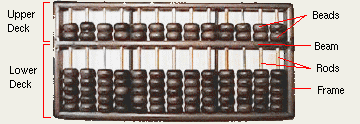| Chinese Way > Daily Highlight | กก |
|
Chinese Abacus: 600 Years and Counting Chinese abacus is a simple device for performing mathematical calculations. Known as the Fifth Invention of Ancient China, the abacus can perform addition, subtraction, division and multiplication; it can also be used to obtain square roots and cubic roots. The Chinese abacus and zhusuan (reckoning by the abacus) were created by a famous mathematician Cheng Dawei of the Ming Dynasty (1368-1644), known worldwide as "the great master of zhusuan". In Japan, he is worshipped as "the God of Arithmetics," and August 8 was established as the "abacus festival" in commemoration of him.
The
abacus is used for making calculations in the Middle East, Asia and Russia; one
particular use for the abacus is to teach children simple mathematics,
especially multiplication, since it simplifies the addition and subtraction of
Roman numerals and is easy to learn. The abacus is an excellent substitute to
memorizing the multiplication table -- a particularly detestable task for
children. It is also an excellent tool for teaching other basic numbering
systems since it is easily adaptable.
|
|||||
 |
